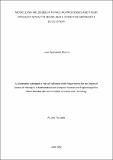Modelling wildebeest foraging processes and their interaction with zebra and lion in the Serengeti ecosystem
Abstract
Animal movements and foraging processes for the migrating species, especially wildebeests and
zebras, and the prey-predator interactions of these prey species with lions are ambiguous
biological characteristics in the Serengeti ecosystem. These complex dynamics help animals to
adapt and survive. To understand such dynamics, investigating factors that determine foraging
efficiency and the prey-predator interaction is worth it. This dissertation presents deterministic
mathematical models to examine wildebeest foraging processes and the prey-predator
interaction of wildebeest, zebra, and lion populations. The first model studies the foraging
processes of migrating wildebeests using the concepts of random walk and diffusive processes.
The model was equipped with data collected from the Serengeti ecosystem from 18 GPS
collared wildebeests and analysed in two spatial dimensions. The qualitative analysis of the
model was performed, and the parameters that regulate foraging efficiency were calculated for
both dry and wet seasons. Numerical simulations were performed, and the results show that
directed movements can explain the great migration of wildebeests to different habitats.
Wildebeests spread across different habitats to utilize the resources through diffusive trends.
The mutual association between wildebeests and zebras was studied by developing the Lotka Volterra reaction-diffusion systems. This model was further modified to form the third model
that includes the predation pressure from lions. The qualitative analyses of the models were
carried out in two dimensions to determine points of equilibrium and the conditions for the
stability and instability of the systems. The explicit Euler method was used to discretize the
models and perform numerical simulations. The stability analyses of the models showed that
wildebeests and zebras population growth approached their respective carrying capacities, and
the absence of one prey species does not affect the existence of the other. The advection and
diffusion parameters in the model produce Turing instabilities. Furthermore, the results show
that both prey species are strongly affected by drought and predation pressure, especially from
lions. Therefore, advection and diffusion of wildebeests and zebras are motivated by the search
for better forage availability and avoidance of predators, while the predator's movement is
motivated by capturing prey.

